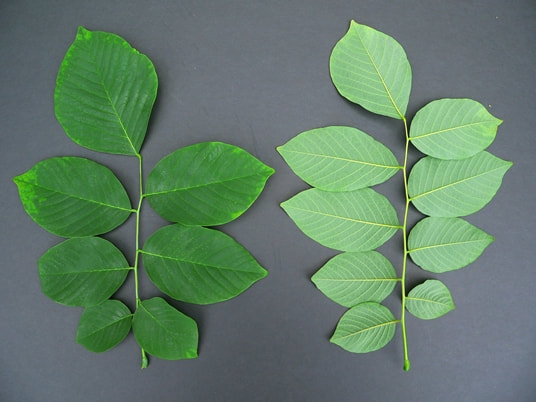Cumberland Plateau/Ridge & Valley Mesic Forests
|
Mesic Forests grow in moist cool, protected sites where soils are deep and rich, such as valley floors, ravines, north-facing coves, and in some some large sinkholes. They most often occur on limestone-based soils in this ecoregion, but are sometimes found in cool, more acidic sites. These stunning communities contain a large diversity of mesophytic trees, including yellow wood, basswood, southern sugar maple and yellow buckeye, as well as lush carpets of spring wildflowers.
|
|
Indicator species: southern and northern sugar maples, Ohio and yellow buckeyes, tulip poplar, and basswood
What's special: these forests can be lush and beautiful, especially in the spring on calcium-rich soils, when a rich diversity of spring wildflowers that are uncommon elsewhere in the state - some only occur in these forests - bloom here, including celandine poppy, twinleaf, columbine, Virginia bluebells, bent trillium, and fern-leaf phacelia. The deep, moist soils and leaf litter support amphibians and snails.
Conservation: these forests can grow into very old forests, given time and with only small-gap disturbance regimes. Those over high pH substrates are particularly special. They should be preserved and kept free from fire, logging, or other human disturbance..
Related communities: Calcareous cliffs can be embedded within this community. Grades to Bottomlands and Floodplains.
What's special: these forests can be lush and beautiful, especially in the spring on calcium-rich soils, when a rich diversity of spring wildflowers that are uncommon elsewhere in the state - some only occur in these forests - bloom here, including celandine poppy, twinleaf, columbine, Virginia bluebells, bent trillium, and fern-leaf phacelia. The deep, moist soils and leaf litter support amphibians and snails.
Conservation: these forests can grow into very old forests, given time and with only small-gap disturbance regimes. Those over high pH substrates are particularly special. They should be preserved and kept free from fire, logging, or other human disturbance..
Related communities: Calcareous cliffs can be embedded within this community. Grades to Bottomlands and Floodplains.
|
Plants Click on a plant name to see images. Plants listed n order by scientific name. Soil/bedrock nutrient traits, such as "rich", "calcareous" and "mafic" is provided in The Flora of the Southern and Mid-Atlantic States, here. Trees Southern sugar maple Acer floridanum (especially calcareous and mafic) Northern sugar maple Acer saccharum (especially calcareous and mafic) Yellow buckeye Aesculus flava Ohio buckeye Aesculus glabra (over limestone) Musclewood/American hornbeam Carpinus caroliniana Bitternut hickory Carya cordiformis (especially in rich soils) Yellowwood Cladastris kentuckea (esp. calcareous or mafic) American beech Fagus grandifolia var. carolina White ash Fraxinus americana (rich soils, and in calcareous or mafic soils on dry sites) Common silverbell Halesia tetraptera Tulip-tree Liriodendron tulipifera Cucumber magnolia Magnolia acuminata (especially mafic or calcareous) Fraser magnolia Magnolia fraseri Umbrella magnolia Magnolia tripetala Ironwood/ American hop-hornbeam Ostrya virginiana (especially over basic bedrock) Northern red oak Quercus rubra White basswood Tilia americana var. heterophylla (rich soils) Shrubs Painted buckeye Aesculus sylvatica (nutrient-rich forests) Common pawpaw Asimina triloba (nutrient-rich forests) Strawberry bush Euonymus americana Smooth hydrangea Hydrangea arborescens Northern spicebush Lindera benzoin (slopes with circumneutral soils) Ground Cover Wildflowers Dolls'-eyes Actaea pachypoda (rich forests) Black cohosh Actaea racemosa (rich to very fertile forests) Sharp lobed hepatica Anemone acutiloba (esp. mafic or calcareous) Round lobed hepatica Anemone americana Canada columbine Aquilegia canadensis (esp. calcareous and mafic rocks) Jack-in-the-pulpit Arisaema triphyllum Wild ginger Asarum canadense (rich, circumneutral soils) Wild hyacinth Camassia scilloides (limestone) Cutleaf toothwort Cardamine concatenata (rich forests) Broadleaf toothwort Cardamine diphylla (rich forests) Blue cohosh Caulophyllum thalictroides (rich forests) Devil's-bit Chamaelirium luteum Northern horsebalm Collinsonia canadensis (rich forests, especially over mafic or calcareous bedrock) Yellow lady's-slipper Cypripedium parviflorum (rich) Harbinger-of-spring Erigenia bulbosa Dimpled trout lily Erythronium umbilicatum Wild geranium Geranium maculatum Summer bluet Houstonia purpurea Goldenseal Hydrastis canadensis (very nutrient rich soils over mafic or calcareous rock) Crested iris - Iris cristata (rich forests) Twinleaf Jeffersonia diphylla (calcareous or mafic) Virginia bluebells Mertensia virginica (fertile) Hairy sweet cicely Osmorhiza claytonii (fertile forests) Smooth sweet cicely Osmorhiza longistylis (fertile forests) Ginseng Panax quinquefolius (nutrient rich forests, tending to avoid richest coves) Fernleaf phacelia Phacelia bipinnatifida Blue phlox Phlox divaricata (circumneutral soils) May-apple Podophyllum peltatum (rich forests) Yellow mandarin Prosartes lanuginosa Carolina petunia Ruellia caroliniensis Bloodroot Sanguinaria canadensis (nutrient-rich forests) Axillary goldenrod Solidago caesia Star chickweed Stellaria pubera Celandine poppy Stylophorum diphyllum Rue anemone Thalictrum thalictroides Foamflower Tiarella cordifolia Catesby's trillium Trillium catesbaei Decumbent trillium Trillium decumbens Bent white trillium Trillium flexipes (mafic or calcareous) Lanceleaf trillium Trillium lancifolium (calcareous) Yellow trillium Trillium luteum (mafic or calcareous) Sweet Betsy/Toadshade trillium Trillium cuneatum (rich forests, usually over mafic or calcareous rocks) Nodding trillium - Trillium rugelii (rich forests, usually over mafic or calcareous rocks) Perfoliate bellwort Uvularia perfoliata Halberd-leaf violet Viola hastata (often acidic coves) Tall white violet Viola canadensis Ferns Northern maidenhair fern Adiantum pedatum (especially mafic or calcareous) Rattlesnake fern Botrypus virginianus (especially on nutrient-rich slopes) Silvery glade fern Homalosorus pycnocarpon (very nutrient-rich forests over mafic or calcareous rock) Broad beech fern Phegopteris hexagonoptera Christmas fern Polystichum acrosticoides Southern lady fern Athyrium asplenioides |
Representative Trees in order by scientific name Representative shrubs in order by scientific name
Representative wildflowers in order by scientific name
Representative ferns in order by scientific name
|





























































